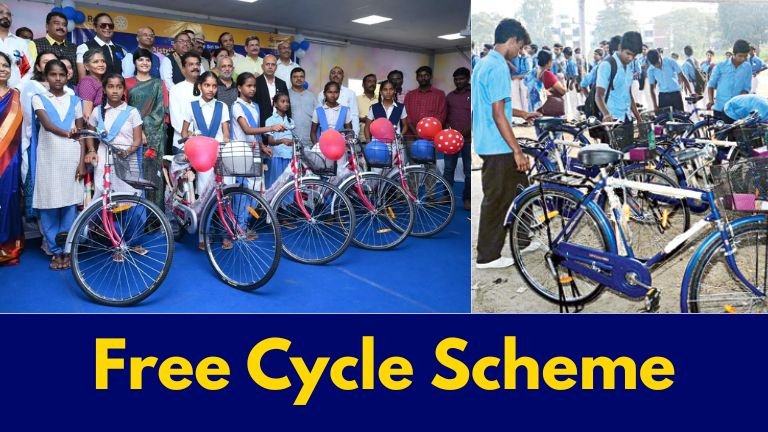Free Cycle Scheme 2025: A Step Towards Mobility, Education, and Empowerment
In a significant push to support education, mobility, and sustainable transport, various state governments across India have introduced the Free Cycle Scheme. This initiative is aimed at empowering economically weaker sections, particularly students and laborers, by providing them with bicycles free of cost. The primary objective is to remove transportation hurdles that hinder access to education and employment, especially in rural and remote regions.
Objective of the Scheme
The Free Cycle Scheme is designed with multiple social and economic goals in mind:
-
Improving School Attendance: In many villages, students, especially girls, walk several kilometers to reach school. Bicycles enable regular attendance and reduce dropouts by ensuring safe and quick transport.
-
Supporting Poor Families: For families struggling financially, daily travel expenses can be burdensome. Free bicycles ease this load, making education and work more accessible.
-
Promoting Green Transport: Bicycles are non-polluting and energy-efficient. By encouraging their use, the scheme contributes to reducing carbon emissions and promotes environmentally friendly practices.
-
Health and Fitness: Regular cycling improves physical fitness, benefiting students and workers alike.
-
Empowering Women and Girls: By ensuring safe and independent travel, bicycles offer mobility to female students, promoting gender equality and access to higher education.
Who Benefits from the Scheme?
The scheme targets several categories of beneficiaries, depending on the state’s implementation:
-
Students in Government Schools: Typically students in Classes 8 to 12 are prioritized.
-
College-going Youth: Some states extend the benefit to undergraduates, especially those from rural areas.
-
Girls and Women Students: Special emphasis is placed on empowering girls to reduce dropout rates and ensure continuity of education.
-
Daily Wage Laborers: Workers who need to travel to job sites or markets also benefit in some states.
-
Farmers and Rural Workers: Especially in areas where transportation infrastructure is lacking.
Eligibility is generally based on income criteria, distance from educational institutions, and enrollment in government-recognized schools or colleges.
Implementation and Distribution Process
To ensure transparency and effectiveness, the scheme typically follows a structured approach:
-
Identification of Beneficiaries: Local authorities and school administrators compile lists of eligible students and workers based on predefined eligibility criteria.
-
Procurement of Bicycles: The government invites tenders from manufacturers to supply durable and quality-checked bicycles.
-
Distribution Events: Bicycles are handed out at schools or designated centers during official programs. In some states, cash vouchers or coupons are given to beneficiaries to purchase cycles.
-
Monitoring: School authorities and district education officers track the distribution and follow up to ensure proper usage.
-
Awareness Drives: Notices and public campaigns are conducted to inform eligible people about the scheme and its benefits.
Key Benefits of the Free Cycle Scheme
-
Improved Educational Access: Students who earlier skipped school due to distance now attend regularly.
-
Cost Savings for Families: The daily savings on transport significantly ease the financial burden on poor families.
-
Time Efficiency: Time spent commuting is greatly reduced, giving students and workers more time for studies or employment.
-
Environmentally Friendly: The initiative promotes the use of clean transport and reduces dependency on fuel-based vehicles.
-
Independence and Empowerment: Particularly for girls, a bicycle provides a safe and independent way to travel, boosting their confidence.
-
Support for Rural Development: Enhanced mobility allows better access to schools, health centers, and marketplaces in rural areas.
Challenges in Implementation
Despite its many benefits, the scheme also faces certain obstacles:
-
Poor Bicycle Quality: In some instances, bicycles are not durable or suited for rough terrains.
-
Lack of Repair Services: Especially in interior areas, maintenance facilities are rare, and repair costs may be unaffordable.
-
Delayed Rollout: Bureaucratic hurdles often result in late distribution, making cycles less useful within the academic year.
-
Corruption and Misallocation: There are reports in some regions of cycles being given to ineligible individuals or being sold in local markets.
-
Limited Awareness: Some potential beneficiaries remain uninformed about the scheme and miss out.
Suggestions for Better Implementation
-
Strict Quality Checks: Ensure only reliable and long-lasting cycles are selected through transparent procurement processes.
-
Establish Local Repair Centers: Set up service centers at the village or taluk level for easy and affordable repairs.
-
Timely Distribution: Make sure cycles are distributed before the start of the school or agricultural season.
-
Grievance Redressal System: Introduce an easy-to-access complaint mechanism for issues like misuse or faulty bicycles.
-
Involvement of Local Bodies: Encourage active participation from panchayats, school management committees, and local NGOs in implementation and monitoring.
State-Level Success Stories
Several Indian states have successfully demonstrated the effectiveness of this scheme:
-
Bihar: Marked a significant improvement in female literacy and school attendance after cycles were given to girl students.
-
Tamil Nadu: Consistently distributes cycles to higher secondary school students, ensuring better access to education.
-
Karnataka: Targets students from marginalized communities like SC/STs and those in remote areas, helping bridge the rural-urban education gap.
These success stories illustrate the scheme’s power in transforming lives when properly managed.
Free Cycle Scheme Application
Conclusion
The Free Cycle Scheme is not just about giving a bicycle; it’s about giving access—to education, employment, health, and empowerment. For millions of families, especially in rural India, a bicycle is more than a mode of transport—it’s a lifeline. When executed efficiently, this simple initiative can help shape a more inclusive and progressive society, ensuring no one is left behind due to lack of mobility.
